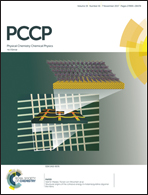Effect of lithium-trapping on nitrogen-doped graphene as an anchoring material for lithium–sulfur batteries: a density functional theory study†
Abstract
N-Doped graphene (NG) has been widely used as a cathode material for lithium–sulfur (Li–S) batteries due to its strong interaction with lithium polysulfide (LiPS) species. However, strong interaction between the NG substrate and the LiPS molecules induces undesirable molecular structure decomposition of LiPS. Due to the strong interaction between Li and NG, Li-trapping occurs during battery operation. Therefore, in this study, Li-trapped NG (LiNG) is introduced as a possible structure of NG, and the structural stability of LiNG under applied electric potential is examined. The effect of Li-trapping on the properties of NG as an anchoring material for Li–S batteries is investigated using density functional theory calculations. Li-trapping relieves the strong interaction between NG and LiPS, thereby avoiding decomposition of the LiPS molecule. Although the interaction between the LiPS molecule and the substrate is weakened, additionally formed interaction after Li-trapping, which is between Li in the substrate and S in the molecule, enables LiNG to suppress the shuttle effect. LiNG shows advanced anchoring behavior that suppresses the shuttle effect without any molecular decomposition of LiPS. This finding provides a further understanding of the effect of Li-trapping on the anchoring properties of NG for Li–S batteries.



 Please wait while we load your content...
Please wait while we load your content...